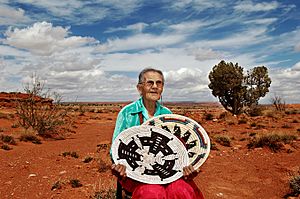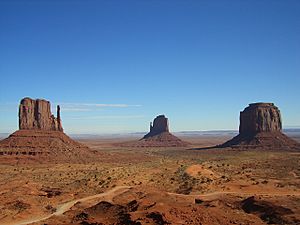Mary Holiday Black facts for kids
Quick facts for kids
Mary Holiday Black
|
|
|---|---|

Black with two of her baskets in 1995
|
|
| Born |
Mary Holiday
c. 1934 Monument Valley, Utah, U.S.
|
| Died | December 13, 2022 |
| Resting place | Monument Valley Community Cemetery |
| Nationality | Navajo Nation, American |
| Style | Navajo weaving, coiled basketry |
| Spouse(s) | Jessie Black (1950s–1994) |
| Awards | National Heritage Fellowship (1995) |
Mary Holiday Black (born around 1934 – died December 13, 2022) was a very important Navajo artist. She was known for making beautiful baskets and weaving textiles. In the 1970s, she played a big part in bringing back Navajo basket weaving. She tried new designs and ways of making baskets. She even created a special style called "story baskets."
In 1995, Mary Holiday Black made history. She became the first Navajo artist to win a National Heritage Fellowship. This is a very important award from the National Endowment for the Arts. Her amazing baskets have been shown in museums and collections all over Utah.
Her Early Life
Mary Holiday was born around 1934 in Monument Valley, Utah. Her parents were Teddy and Betty Holiday. She had six brothers and sisters. As the oldest daughter, she helped a lot at home. She never went to school. When Mary was 11 years old, she learned how to weave baskets. She learned this skill from one of her grandmother's relatives.
In the 1950s, she married Jessie Black. They had 11 children together. Jessie passed away in 1994. Mary taught her weaving skills to nine of her children. Many of them also became well-known basket makers. Her children, like Jamison Black and Sally Black, are respected artists too. Mary Holiday Black only spoke the Navajo language. She never learned English and used an interpreter when she needed to.
Bringing Back Basket Weaving
For many years, fewer Navajo people were making baskets. Weaving rugs became a better way for women to earn money. By the 1960s, there were only a few Navajo basket makers left. For special ceremonies, they even bought baskets from nearby Ute and Paiute people.
In the 1970s, Mary Holiday Black helped to revive Navajo basket weaving. She tried new ideas and ways of making baskets. She made ceremonial baskets much bigger than before. She used natural plant dyes to create softer colors. She also added designs from ancient Native American pottery and rock art.
Mary started weaving stories into her baskets. These "story baskets" showed scenes from Navajo oral history. Some of her themes included "Placing the Stars" and "Changing Bear Woman." At first, some people in the Navajo community were unsure about her new ideas. But over time, her work became widely accepted.
In 1993, Mary Holiday Black received the Utah Governor's Award for the Arts. Then, in 1995, she won the National Heritage Fellowship. This made her the first artist from Utah and the first Navajo artist to receive this honor. Many people called her "the matriarch of Navajo basketry." This means she was like the respected mother of Navajo basket making.
In 2006, Mary Holiday Black took part in the Smithsonian Folklife Festival. In 2013, baskets made by the Black family were shown in a big museum exhibit. It was called "Weaving a Revolution: A Celebration of Contemporary Navajo Baskets." Her work has been displayed in many places. These include the Natural History Museum of Utah and the Utah State Folk Arts Collection.
Her Passing
Mary Holiday Black passed away on December 13, 2022.


